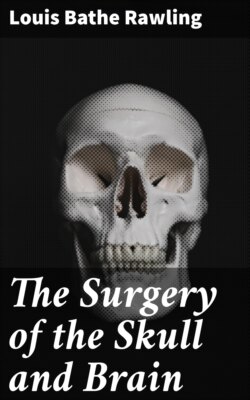Читать книгу The Surgery of the Skull and Brain - Louis Bathe Rawling - Страница 19
На сайте Литреса книга снята с продажи.
The cortical motor and sensory areas.
ОглавлениеTable of Contents
The researches of Sherrington and Grünbaum,[2] Campbell,[3] and others tend to show that the cortical motor areas are situated entirely anterior to the central fissure or fissure of Rolando, extending above well over on to the mesial aspect of the brain, though not so far as the calloso-marginal fissure, and in the downward direction to within a short distance of the fissure of Sylvius. In the posterior direction the motor area includes the anterior boundary and part of the bottom of the fissure of Rolando, whilst in front it spreads, by means of gyri annectantes, on to that part of the brain which lies anterior to the precentral sulcus. The anterior termination is indefinite, but the motor strip is, on an average, not more than 3⁄4 inch in breadth.
The genua of the Rolandic fissure are said to bear a more or less definite relation to the motor areas. In my experience, however, they are too variable, and any importance which might obtain is further diminished by the fact that the surgeon should never rest content with that limited exposure of the brain which was so much in vogue till recent years. The suspected region is widely exposed by osteoplastic flap, and if doubt exists as to the particular part of cortex exposed the question is accurately settled by faradization.
This motor strip corresponds, from above downwards, to the movements of the contralateral lower extremity (toe to hip), trunk, upper extremity (shoulder to fingers), neck and face. It is a point of some general utility to bear in mind that the temporal crest intervenes approximately between the regions responsible for the movements of the upper extremity (above the crest) and those for the movements of the head and face (below the crest).
Fig. 3. The Cortical Motor and Sensory Areas.
On the left side of the head—in normal right-handed individuals—the motor speech area of Broca corresponds to the third left frontal convolution, in the angle between the anterior and posterior horizontal limbs of the Sylvian fissure.
The ‘primary registration’ of ‘common sensation’ occurs in the post-central gyrus, immediately posterior to the fissure of Rolando. This tactile area occupies a position behind the fissure of Rolando similar in extent to that occupied by the motor area in front. It commences at the bottom of the fissure of Rolando and extends backwards over rather more than half the exposed area of the post-central convolution. It reaches down to near the Sylvian fissure and extends over on to the mesial aspect of the brain. Furthermore, it is probable that sensation in any given part lies on more or less the same level as the corresponding motor area.
Immediately posterior to the tactile area and occupying the posterior and upper part of the post-central convolution, the area responsible for muscle-sense is situated.
Stereognosis—memory pictures, object perception, &c.—is referred to the superior parietal lobe.
Primary visual impressions are received in the occipital lobe, more especially on the mesial aspect thereof.
Finally, the four areas concerned in speech—motor speech, writing, reading, and hearing—are anatomically separated from one another and yet closely associated, so much so that one can hardly be involved without the other. The motor speech centre of Broca has already been mentioned as occupying—in right-handed individuals—the posterior part of the third left frontal convolution. Writing lies immediately above and in front, in the posterior part of the middle frontal gyrus, auditory impressions are received in the posterior and upper part of the first temporo-sphenoidal lobe, whilst the power of reading is dependent on the integrity of the supramarginal and angular gyri (see also Fig. 57).
Smell and Taste lie in close relation to the anterior pole of the temporo-sphenoidal lobes.
[1] Reid’s base-line is a line drawn around the skull, starting in front at the lower border of the orbit and passing through the central point of the external auditory meatus.
[2] Proceedings and Philosophic Transactions of the Roy. Soc., 1901.
[3] Localization of Cerebral Function. Camb. Univ. Press, 1905.
